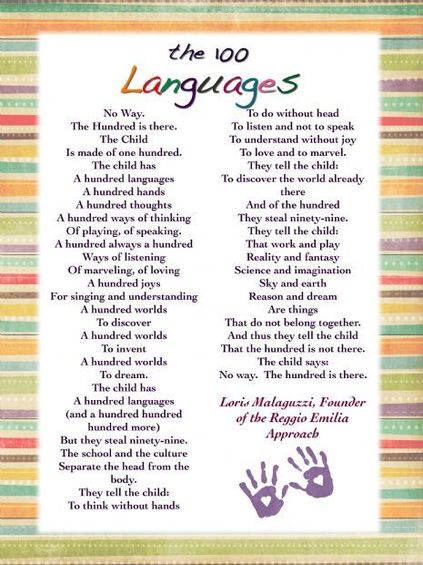
Loris Malaguzzi was an early childhood educator who founded the educational philosophy known as the Reggio Emilia Approach. He was instrumental in the creation of a network of municipal preschools and infant-toddler centers in the Italian town of Reggio Emilia.
https://dspace.library.uvic.ca/bitstream/handle/1828/8015/Slipp_Kari_MEd_2017.pdf?sequence=3&isAllowed=y
The Reggio Emilia approach to early childhood education views young children as individuals who are curious about their world and have the powerful potential to learn from all that surrounds them. Educational, psychological, and sociological influences are important factors to consider in understanding children and working to stimulate learning in inappropriate ways. Reggio teachers employ strategies such as exposing children to a wide variety of educational opportunities that encourage self-expression, communication, logical thinking, and problem-solving.
Principles of the Reggio Emilia Approach:
The Reggio approach follows four major principles. These are:
Emergent Curriculum. A classroom’s curriculum stems from the particular interests of children. Curriculum topics are derived from talking with children and their families, as well as from things that are known to be interesting to children (puddles, dinosaurs, and so on). Teachers compare notes and observations in team planning sessions to decide which projects would be best suited to children in their classes, what materials will be needed, and how they can encourage parents and the community to become involved.
In-Depth Projects. These projects are thorough studies of concepts and ideas based on the information gathered about children’s interests. Projects are often introduced to children as adventures and can last anywhere from a week or two to the entire school year. Teachers act as advisors on these projects, helping children decide in which direction they would like to take their research, how they can represent what they learn, and what materials would be best suited for their representations.
Representational Development. This principle takes into account Howard Gardner’s concept of multiple intelligences. The Reggio Emilia approach calls for the presentation of new ideas and concepts in multiple forms, such as print, art, drama, music, puppetry, and so on. Varied presentations ensure that all children have the chance to understand and connect with the concepts being explored.
Collaboration. The idea of collaboration is seen as necessary to further a child’s cognitive development. Groups both large and small are encouraged to work together to problem-solve using dialogue, comparisons, negotiations, and other important interpersonal skills. Each child’s voice is heard in order to promote a balance between a sense of belonging to the group and a sense of self.
The Teacher’s Role
Teachers play a dual role in the Reggio Emilia classroom. Their primary role is to learn alongside children, becoming involved in group learning experiences as a guide and resource. A Reggio Emilia teacher must always carefully observe and track the growth of children and the classroom community. Reggio teachers will also take time to reflect on what they have learned about themselves and their teaching.
Observation and Documentation
Documentation of the growth of both children and teachers is another important component of the Reggio Emilia approach. Photos of children at work and play, along with dictations of their experiences, help teachers and parents learn more about what does and do not work for a child. Teachers can then adjust the dynamics of their classrooms accordingly.
The Classroom as Teacher
The classroom is referred to as the “third teacher” in Reggio schools. Much like the Montessori approach, great care is taken to construct an environment that allows for the easy exploration of various interests. The documentation mentioned above is often kept at children’s eye level so that they, too, can see how they are progressing over the year. Items from home, such as real dishware, tablecloths, plants, and animals, contribute to a comforting, “homey” classroom environment.
All of these principles and beliefs combine to make Reggio Emilia classrooms an interesting and highly effective method of expanding children’s minds—one adventure at a time.
Using Reggio Emilia Techniques in Your Own Classroom
Organize your classroom in a way that helps children make thoughtful decisions about the materials they would like to use for different projects
Document children’s progress using many different methods, such as video, photographs, tape recordings, work portfolios, and recorded dictations
Form a group of other teachers and parents to help compare information and adjust to the special needs and interests of children

No comments:
Post a Comment